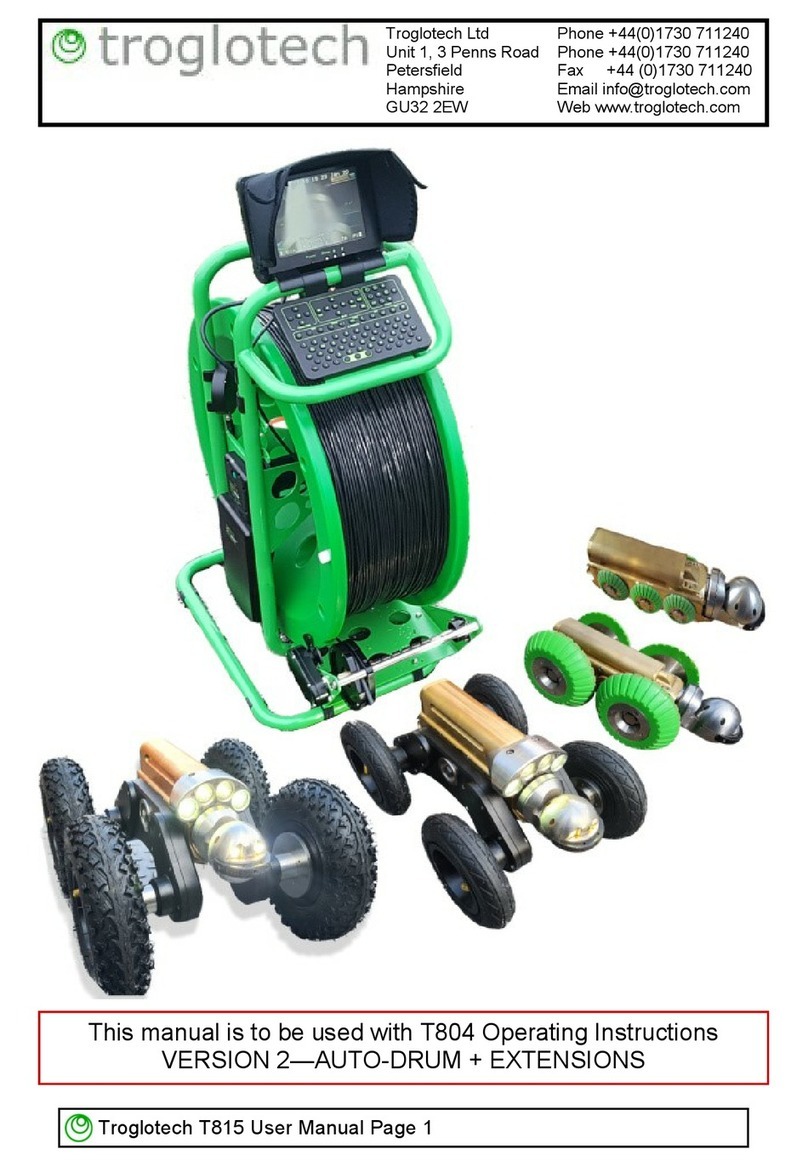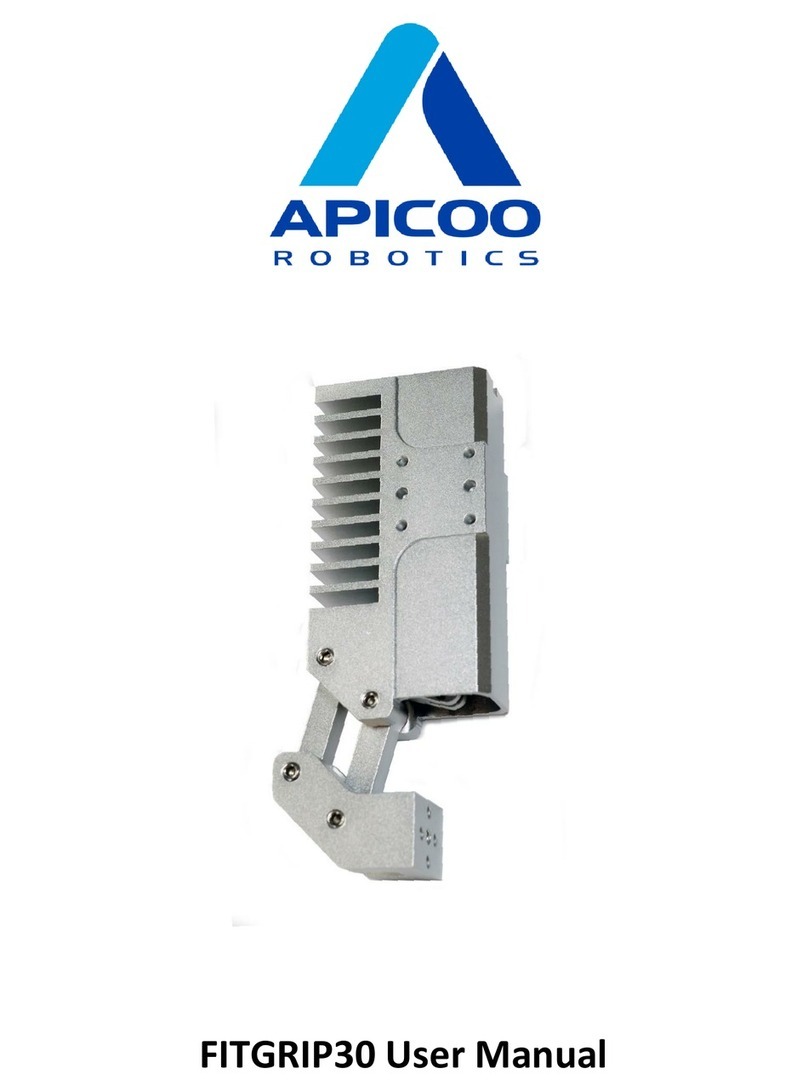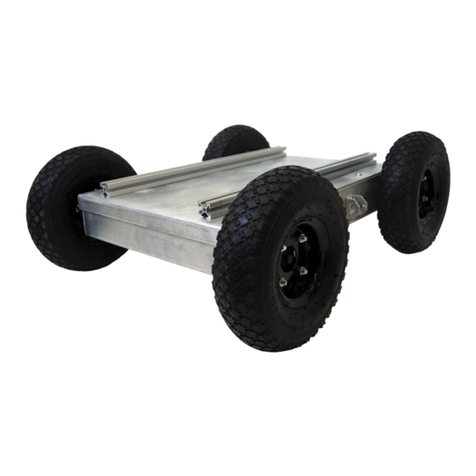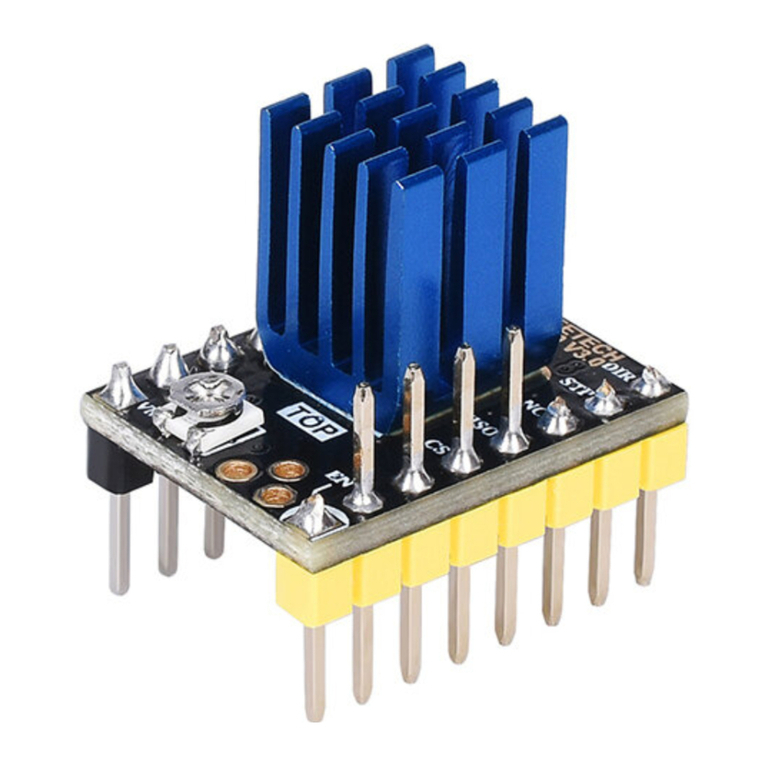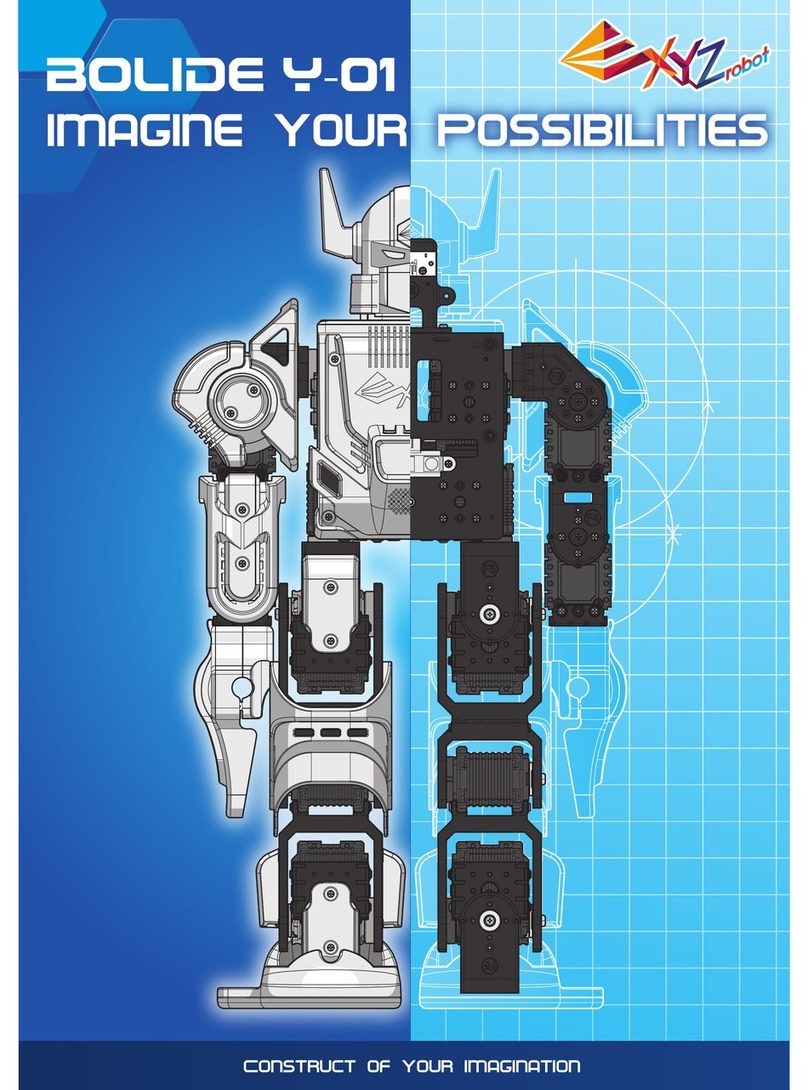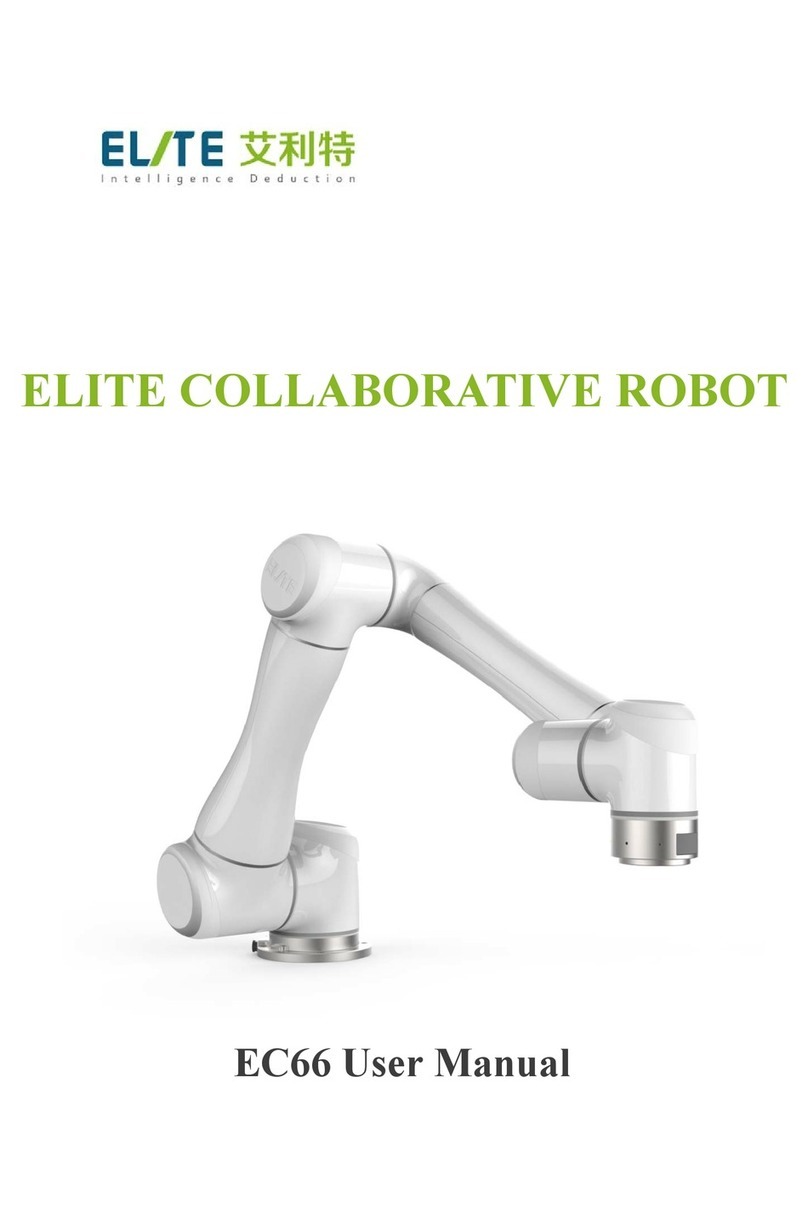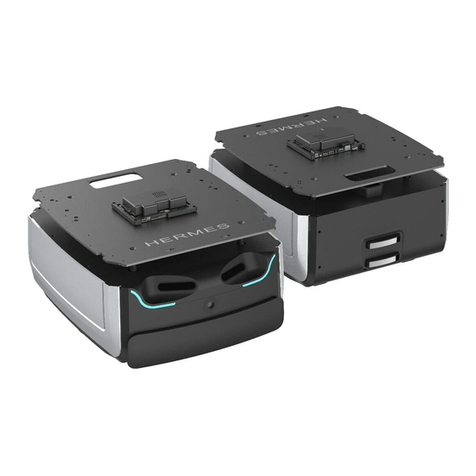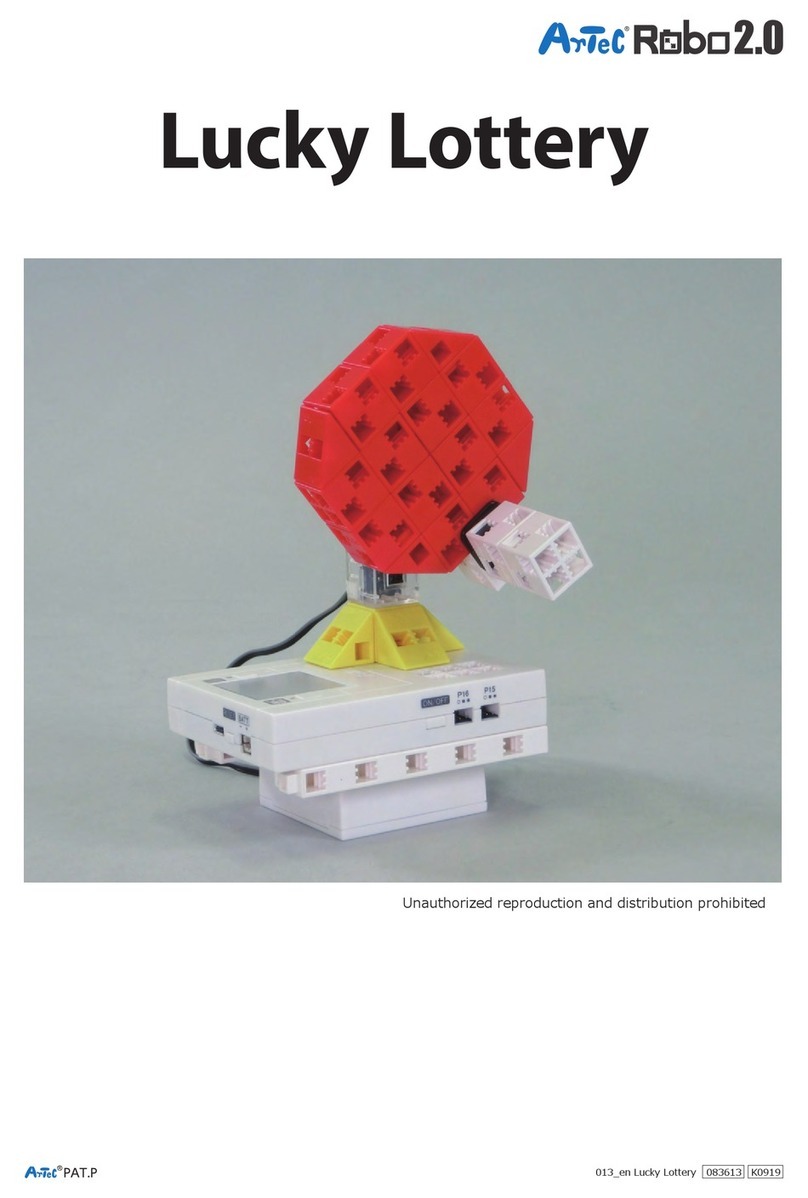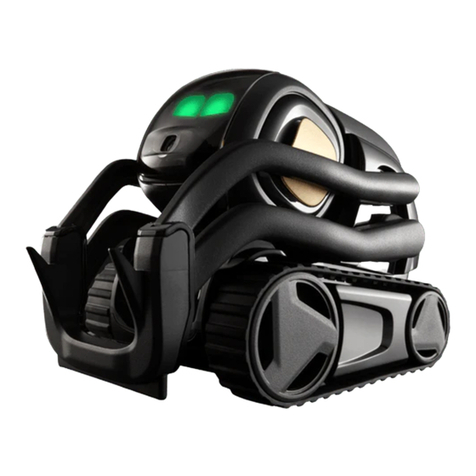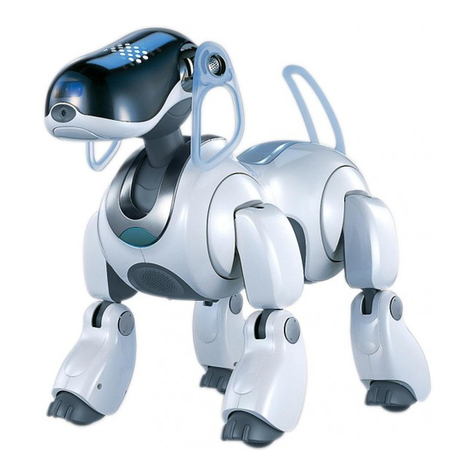Troglotech T815 Instruction manual

Troglotech T815 Crawler Workshop Manual Page 1
WORKSHOP MANUAL — T815 CRAWLER
Troglotech Ltd Phone +44(0)1730 711240
Unit 1, 3 Penns Road Phone +44(0)1730 711240
Petersfield Fax +44 (0)1730 711240
Hampshire Email info@troglotech.com
GU32 2EW Web www.troglotech.com

Troglotech T815 Crawler Workshop Manual Page 2
T815 CRAWLER - OVERVIEW
T815 Crawler Overview—Motor Drives
MECHANICS:
The mechanical construction of the T815 crawler enables quick disassembly and
is simple to repair and maintain. NOTE: See https://youtu.be/H5bHqfwd2yg for
video of assembly instructions
The diagram above shows the plain chassis and the two motor/gearbox drive
units. These are manufactured by Troglotech and are not serviceable, in the
unlikely case of malfunction they can be replaced as assemblies and the failed
unit returned to Troglotech for investigation.
The motor drives contain a 3-phase brushless motor and a Troglotech-designed
cycloid gearbox to attain the torque requirements and available volume.
The drive units can be replaced by removing the side metalwork (containing the
drive axles, seals and idler gear) and PCB’s—Note that the drive units are
connected to the Motor Drive PCB’s by a flexible Kapton lead with a ZIF
receptacle at the end—this is disconnected by sliding the lock on the PCB—this
is best done with the Motor Drive PCB still fitted to the chassis

Troglotech T815 Crawler Workshop Manual Page 3
T815 CRAWLER- OVERVIEW
T815 Crawler Overview—PCB’s
The diagram above shows the PCB positions the numbered balloons show the
order in which the PCB’s must be removed, they are connected in such a way
that only the correct order will allow them to be removed without damage.
NOTE: Removal of the Motor Drives (3 and 8) requires the disconnection of the
Kynar flexible connection from the ZIP sockets—be careful as these can be
damaged easily. Disconnection requires that the clasp is pushed towards the
flexible ribbon by around 2mm before it can be removed.
NOTE: Add a small amount of silicon grease between the motor drive PCB and
the pocket in which it is housed to conduct heat away from the driver whenever a
motor drive PCB is replaced

Troglotech T815 Crawler Workshop Manual Page 4
T815 CRAWLER - OVERVIEW
T815 Crawler Overview—PCB’s
The diagram above shows the PCB positions the numbered balloons show the
order in which the PCB’s must be removed, they are connected in such a way
that only the correct order will allow them to be removed without damage.
NOTE: Removal of the Motor Drive (3) requires the disconnection of the Kynar
flexible connection from the ZIP sockets—be careful as these can be damaged
easily. Disconnection requires that the clasp is pushed towards the flexible ribbon
by around 2mm before it can be removed
NOTE: Add a small amount of silicon grease between the motor drive PCB and
the pocket in which it is housed to conduct heat away from the driver whenever a
motor drive PCB is replaced

Troglotech T815 Crawler Workshop Manual Page 5
T815 CRAWLER- OVERVIEW
T815 Crawler Overview—PCB’s
The diagram above shows the PCB positions the numbered balloons show the
order in which the PCB’s must be removed, they are connected in such a way
that only the correct order will allow them to be removed without damage.
NOTE: Removal of the Motor Drive (4) requires the disconnection of the Kynar
flexible connection from the ZIP sockets—be careful as these can be damaged
easily. Disconnection requires that the clasp is pushed towards the flexible ribbon
by around 2mm before it can be removed
NOTE: Add a small amount of silicon grease between the motor drive PCB and
the pocket in which it is housed to conduct heat away from the driver whenever a
motor drive PCB is replaced

Troglotech T815 Crawler Workshop Manual Page 6
T815 CRAWLER - OVERVIEW
T815 Crawler Overview—Drivetrain and External Parts
DRIVETRAIN:
The picture below shows the T815 drivetrain and external parts. The drivetrain
consists of six individual axles with integral gears and two Idler Gears. These parts
are attached to, or held in place by the Tractor Sides which are secured by 12
Allen bolts
To release the Tractor Sides it is good practice to loosen the Front Cover as this
can put force on the sides. The Rear Cover contains the Swivel Connection and
the Sonde Transmitter, it also has apertures for the rear camera and lighting
(both of which are fitted to the Processor/VID PCB)
The Front Cover contains the Camera Pogo PCB, this connects to the camera
(which can be either the T812 Pan & Tilt or the Forward View Camera)
The Connector Block connects to the inserted battery pack and is the input for
all electronics within the Tractor. This, along with the sonde assembly are the
only wired components, all other connections are connector pairs

Troglotech T815 Crawler Workshop Manual Page 7
T815 CRAWLER- OVERVIEW
T815 Crawler Overview—Electronic Operation
The electronic operation of the Crawler is controlled by the Processor/VID PCB
(TC81511011). With a Battery Pack fitted to the Crawler the battery power is
disconnected from all PCB’s apart from the Processor and the TC81510011
Power Control PCB. The latter provides power to the Processor PCB via a 1K
resistor called ‘BAT SAFE’
BAT SAFE is regulated on the Processor PCB to provide a low-current 5V supply
for a sensing circuit as seen below. When the Display Unit is switched ON the
small voltage on Video+ve that is present at the end of the cable is detected by
this circuit. The detected voltage produces a HIGH level on ‘WAKE’ and this is
conducted to the Power Control PCB to switch ON the battery supply to the
complete electronics.
At switch ON the 5V power supply becomes active and is used to keep ‘WAKE’ at
a high level for a few seconds via C89—this period is long enough to allow the
Processor to start and hold ‘KEEP AWAKE’ high whilst the cameras produce video
and TTDS communications are established to ensure that the power remains ON.
Once the 5V supply is operational Video+ve will drop in DC voltage as the video
signal is transmitted.

Troglotech T815 Crawler Workshop Manual Page 8
T815 CRAWLER - OVERVIEW
T815 Crawler Overview—Electronic Operation Continued
The picture below shows the battery switching section of the Power Control PCB.
If there is a high level on ‘WAKE’ then power is made available at Motor+ve via
IC11 which supplies power for the complete crawler including the Motor Drive
PCB’s and the PSU which provides the 5V and 15V supplies.
The picture below shows the Power Supply (TC81509011) which produces 5V and
15V from the Power+ve rail—it’s source is the Motor+ve supply from the Power
Control PCB—Motor+ve and Power+ve are kept separate through the Interconnect
PCB’s from the Power Control PCB to reduce electronic noise which may affect the
video picture.
This Power Supply is the voltage source for all the electronics and cameras on the
crawler, however the Motor+ve supply is used as a raw supply for the Motor Drives
and additional lighting (large lighthead and reversing lights). The voltage from the
battery can drop below 13V which is unsuitable for the T815 camera head which is
why a separate 15V supply is available.

Troglotech T815 Crawler Workshop Manual Page 9
T815 CRAWLER- OVERVIEW
T815 Crawler Overview—Electronic Operation Continued
Once the Power Supply is established, the Processor continually communicates
with the Display Unit of the Cable Drum via TTDS signals that are present on
Video+ve. As long as TTDS data is stable and the data contains the
’KEEP_ALIVE_BIT’ (this is set as long as the Display Unit has the correct crawler/
drum software) the processor will hold ‘KEEP AWAKE’ high, which, in turn, holds
‘WAKE’ high. TTDS only works when either the front or rear camera is in
operation, TTDS needs a video signal to operate.
If data is not available the crawler will switch back OFF again. If this cycling
continues, it indicates that the voltage on Video+ve is present but TTDS data is
incorrect or missing. This behaviour will be seen if the software for the Display Unit
(both MAIN and COMMS) has not been updated; pre-T815 software does not
include the ’KEEP_ALIVE_BIT’ bit on TTDS data.
Once TTDS communications are established and the correct data is received the
processor will start communicating with the internal parts via IIC serial bus
The processor has a number of tasks:
Continually send/receive TTDS data
Initialise all IIC devices
Initialise the T812 camera head (if fitted)
Initialise the two motor drives to a safe state
Communicate with the Display Unit via TTDS
Select the video source between front and rear cameras
Switch ON/OFF rear lights
Switch ON/OFF large lighthead
Initialise the accelerometer
Read the accelerometer to get inclination data
Transmit the inclination to Display Unit via TTDS
Switch sonde ON/OFF
Read EEPROM to get calibration data
Get pressure sensor data and calculate true pressure
Get IIC data from current/voltage monitors
Calculate true voltage/current
Transmit voltage/current to Display Unit via TTDS
Calculate crawler orientation for auto-steering
Determine maximum motor speed from voltage data

Troglotech T815 Crawler Workshop Manual Page 10
T815 CRAWLER - OVERVIEW
T815 Crawler Overview—Electronic Operation Continued
Once the processor has initialised all PCB’s and the T812 camera it will operate
the crawler speed, direction and camera orientation and selection via commands
from the Display Unit via TTDS:
Continually send/receive TTDS data
Control the T812 camera head
Control the motor drives speed and direction
Select the video source between front and rear cameras
Switch ON/OFF rear lights
Switch ON/OFF large lighthead
Read the accelerometer to get inclination data
Switch ON/OFF the sonde
Get pressure sensor data and calculate true pressure
Get IIC data from current/voltage monitors
Return Voltage/Current data via TTDS
Calculate crawler orientation for auto-steering
Determine maximum motor speed from voltage data
T815 Crawler Integration with AUTO DRUM:
The T850 Auto Drum system is designed to be a transparent addition to a
standard crawler system. However, the crawler changes its behaviour if the
Auto Drum is set to ‘AUTO’ and the crawler direction is set to reverse:
The Auto Drum sends a ‘crawler passive’ command via TTDS
The Display Unit accepts the ‘crawler passive’ command
The Display Unit sends out a ‘crawler passive’ command to the crawler
The crawler does not engage reverse and switches OFF the brakes
The behaviour above requires software to be upgraded in:
The Crawler
The MAIN Display Unit software
The COMMS Display Unit software
Without these software upgrades the crawler will enable its motor drives in reverse
and the Auto Drum will pull the crawler slightly faster than the wheel speed, this
substantially increases the Auto Drum current demand.

Troglotech T815 Crawler Workshop Manual Page 11
T815 CRAWLER– FAULT FINDING
T815 Crawler—Fault Finding—appears completely dead
Fault finding of the crawler can be simplified by understanding the behaviour at
start-up.
If a crawler does not respond when connected to the cable:
1. Check that there is 5V available between the inner and outer sliprings on
the cable. The Display Unit must be switched ON for a voltage to be
present. A lack of 5V on the cable means that there is a problem with the
above-ground equipment or the cable.
2. If the sliprings do have a 5V signal then try pushing the crawler—as long as
the crawler battery has some charge, pushing the crawler with the large
wheels fitted usually generates enough voltage to start the crawler. If the
crawler does not initialise then remove the battery and check for a voltage
at the pins as shown below:
Be careful with the meter probes as it is easy to short between the probe and the
metal case of the battery. Neither of the battery terminals is connected to the
battery metalwork—check for an infinite resistance between all pins and the battery
metalwork
If a voltage over 14V is present on the crawler battery then further investigation of
the crawler will be necessary, but ensure the battery is fully mated with the
connector block and there is no debris around the connectors

Troglotech T815 Crawler Workshop Manual Page 12
T815 CRAWLER - FAULT FINDING
T815 Crawler—Fault Finding—appears completely dead—continued
If the battery has a good charge, the cable has 5V available, all connections are
clean and the battery is pushed fully home, then the crawler will need dismantling
to find the cause.
The most likely cause of failure is always water ingress, whether this is from
a damaged cable or the crawler being pressurised with an air-supply that
contains moisture. The most likely point of access is the swivel-connection on
the rear cover of the crawler
The rear cover is simply held on with four large
Allen bolts as shown to the right.
Be aware that there is a connector pair
between the rear cover and the processor
PCB—do not apply any sideways force
when removing the rear cover.
The picture to the bottom-right shows the
crawler with the rear cover removed. The
Processor is the outer PCB as shown. SK5 is the black 10-way connector that can
be seen at the bottom centre of the picture. If any moisture is present then this
socket will show damage, possibly with black burn-marks around the pins.
If the Processor PCB is damaged then it will need to be replaced. Where severe
water ingress is seen, other PCB’s may need to be replaced, it is usually the lower
part of each PCB that has water damage.
Where any PCB is damaged it is possible
that the battery voltage (13V—17V) has
been conducted to other PCB traces.
The length of time that the crawler has been
operated with water ingress will determine
the amount of damage done to other PCB’s
and the camera head.
In severe cases of water ingress where the
battery voltage has been conducted to the
IIC Bus traces or to the 5V traces then both the crawler PCB’s AND the camera
head PCB’s may all be damaged beyond repair.
Water ingress nullifies the warranty as this indicates use without pressurisation.

Troglotech T815 Crawler Workshop Manual Page 13
T815 CRAWLER– FAULT FINDING
T815 Crawler—Fault Finding—appears completely dead—continued
If no moisture is found on the Processor PCB try pushing the Crawler again with
the battery fitted and watch the two LED’s on the Processor:
If the two small LED’s D5 and D6 start flashing that indicates that the 5V supply is
operational and the processor PCB has started initialising. If no flashing is shown
start by replacing the Processor PCB and try pushing the Crawler again for signs
of life at the LED’s.
Where the LED’s do flash but nothing else happens check the voltage between
pins 1 and 2 of PL8—whilst the LED’s are flashing there should be the battery
voltage across these two pins:
If no battery voltage is detected then it is possible that the Power Control PCB or
the traces between that PCB and the Processor PCB are damaged (this includes
all three Interconnect PCB’s and the Power Supply PCB).
At this point if no progress is being made then remove all PCB’s and inspect for
damage from water ingress or signs of any burning or malfunction.

Troglotech T815 Crawler Workshop Manual Page 14
T815 CRAWLER - FAULT FINDING
T815 Crawler—Fault Finding—appears completely dead—continued
The next tests need to be performed on the Power Control PCB—disassemble in
the correct order as shown below:
If there is no visible damage to any of the PCB’s then check the voltage at the
battery connector from the upper connection block on the crawler. This is reached
by removing the front cover.
There are five wires:
1. Battery Positive
2. Battery Positive
3. Battery Negative
4. Battery Negative
5. Power to large
lighthead
If power is available on the Power Control PCB then replace the Power Control
PCB.
Pin 1 is always as shown in the picture to the right on
Picoblade connectors no matter how many ways is
present

Troglotech T815 Crawler Workshop Manual Page 15
T815 CRAWLER– FAULT FINDING
T815 Crawler—Fault Finding—One Drive fails to operate
Where one motor drive fails to operate it is most likely that the connection to the
motor driver has failed rather than the Motor Driver itself being at fault.
Alternatively the motor/gearbox may have failed, in this case listen to the crawler
whilst it is placed on the bench with the faulty side uppermost (with the crawler on
its side the lower drive will NOT operate by design). Now it is possible to listen to
the upper drive without the other drive operating.
If the motor can be heard but the axles are not rotating then the Cycloid gearbox
has failed and will need replacing.
If the motor cannot be heard, display the current demand on the Display Unit
(press ‘D’ in VIEW MODE). When the motor is commanded to run check the
current demand, if it does not increase then this is probably an electronic problem
(PCB connectors damaged).
If the current increases substantially then the motor/gearbox is mechanically
jammed and will need investigation and probable replacement
NOTE: The FORWARD Motor Driver controls the RIGHT AXLES
The REAR Motor Driver controls the LEFT AXLES

Troglotech T815 Crawler Workshop Manual Page 16
T815 CRAWLER - FAULT FINDING
T815 Crawler—Fault Finding—Other Problems
Crawler switches ON but T812 head does not initialise, no control over
motors.
This indicates an IIC problem—and this can either be a connection problem
between PCB’s or damage to PCB’s that use IIC to communicate. Sometimes this
can be diagnosed further by selecting reverse on the Display Unit: If the camera
view switches between front and rear views then the IIC Bus IS operational but
connection is lost somewhere on the Interconnect PCB’s (1, 2 and 3).
If no control of anything is possible but the crawler stays awake permanently
(rather than cycling OFF and ON) then it can be assumed that the IIC bus is
shorted to ground somewhere OR that a high voltage has been present between
the Battery Positive supply (or the 15V supply) and components on the IIC Bus
have been damaged.
This situation is always due to mechanical damage or water ingress, usually
starting with the Processor PCB.
It is advised that all PCB’s are removed from the crawler and the PCB set
inspected and then re-assembled without the metalwork on the bench
With the PCB’s in this configuration power can be supplied from a Bench Supply
to SK8 on the Processor PCB (see page 13)
Pin 1 = 12V Current Limit 500mA
Pin 2 = 0V
Pin 3 = Leave open

Troglotech T815 Crawler Workshop Manual Page 17
T815 CRAWLER– FAULT FINDING
Crawler switches ON but T812 head does not initialise, no control over
motors—continued
With power applied as detailed overleaf ensure the current does not exceed
100mA @ 12V. Power demand over this value indicates a short circuit on one of
the PCB’s.
To fault-find the damaged PCB switch OFF and start removing the PCB’s one at a
time starting at the front with the Power Control PCB, then switch back ON again
and check if the current has reduced.
Carry on checking in this fashion with the order: Power Control, Forward Motor
Drive, Interconnect 3, Interconnect 2, Interconnect 1 and finally Rear Motor Drive. If
the current remains high at this point then either the Processor or the Power
Supply PCB is at fault.
IIC BUS CHECKS USING METER OR OSCILLOSCOPE
The IIC Bus is available to be
measured on the Processor
PCB as shown to the right on
pins 1 and 2 of IC16. With
the Processor PCB powered
(LED’s D5 and D6 flashing)
then the IIC Bus should be
operational and at a voltage
of around 3V.
Using a meter connected
between 0V and the pins (0V
can be found on Pin 2 of PL8
seen in the picture) it is expected to see a voltage of 3V, an oscilloscope should
also see bursts of activity on the Bus every 20mS.
If the IIC Bus voltage is at 0V then it is possible that the Processor PCB is
damaged OR that the IIC Bus is shorted to ground somewhere in the PCB set.
Disconnect the battery and use a meter to check the resistance between SDA/SCL
to 0V, the resistance should be over 10,000 Ohms.
If there is a short, remove the Processor PCB and perform the same test—if the
resistance increases the problem is elsewhere in the PCB set

Troglotech T815 Crawler Workshop Manual Page 18
T815 CRAWLER - FAULT FINDING
T815 Crawler—Fault Finding—Other Problems
Crawler switches ON but as soon as the T812 camera head has centralised
the power switches back OFF again. The crawler will continue this behaviour
until the Display Unit is switched OFF (VIDEO PICTURE PRESENT):
This indicates that TTDS data is not being received by the Processor PCB
(possibly main cable damage) or the Processor PCB is not responding to the data.
In this case replace the Processor PCB and see if this cures the problem.
If this fails to repair the crawler then suspect the Display Unit or main cable.
The TTDS amplitude at the crawler must be at a minimum of 600mV above sync
pulses.
Crawler switches ON but as soon as the T812 camera head has centralised
the power switches back OFF again. The crawler will continue this behaviour
until the Display Unit is switched OFF (VIDEO PICTURE NOT PRESENT):
If no video picture is present when the crawler switches ON then suspect the T812
head (or Forward View Camera if fitted). The crawler cannot receive TTDS data
without a video picture being present. If possible try another T812 head or
Forward View camera. If neither is available then try replacing the Processor PCB.
Alternatively, the Processor PCB Video Output Stage may be damaged—replace
the Processor PCB to see if this cures the problem—this damage is usually due to
water ingress in the cable or cable connector at the swivel joint.
Inspect the Processor PCB for water ingress and any burning or contamination of
SK5. This socket is the only connector that has high voltages available (over 50V)
as this is the voltage at which the sonde coil operates. High voltages and moisture
will always cause burns around the connector and Processor PCB.
If there are burns then replace the Processor PCB AND the TC81516011 Swivel
Slipring assembly as this will also be damaged with possible contamination of the
sliprings and pogo’s on the swivel connector.

Troglotech T815 Crawler Workshop Manual Page 19
T815 CRAWLER– MECHANICAL
Water Damage at the rear of the Crawler—Swivel Assembly Removal
To change the PCB first remove the Rear Cover from the Crawler (4 large Allen
bolts) and carefully pull the cover straight back and avoid damaging the mating
connectors. Disconnect the 2-way connector from the sonde from the PCB and
then rotate the swivel connector unit one of the grub screws (17) can be seen as
shown on the bottom right. Completely remove the grub screw and then rotate
the swivel assembly so the next grub screw can be seen and removed. There
are six (6) grub screws that must be removed.
With all 6 grub screws remove the swivel connector. The PCB is held on with
two 1.2 x 3 mm screws. Replace the PCB and replace the o-ring 18 (21 x 1.5)
and liberally grease before replacing the swivel connector. NOTE: The swivel
ring must be placed on the PCB before screwing the PCB in place.
With the Swivel Ring in place and the Swivel Assembly dropped into position
with its o-ring onto the Swivel Ring, refit one grub screw and ensure it fits into
one of the holes in the Swivel Ring. Fully fit the grub screw and then loosen by
1/2 a turn. NOTE: Do not tighten any of the grub screws fully at this stage.
Make sure the Swivel Assembly can be rotated without the grub screw
fouling the PCB. Repeat this for all 6 grub screws and then go around all 6 fully
tightening each grub screw. Refit the Sonde connector.
Grease the large o-ring liberally before refitting the rear cover.

Troglotech T815 Crawler Workshop Manual Page 20
T815 CRAWLER - MECHANICAL
Crawler Disassembly:
The Crawler is simple to disassemble as long as a few precautions are taken:
1. Never use power tools—they can damage the Brass threads
2. Keep the disassembly area clean and dry
3. Have receptacles for any PCB that is removed, they are delicate
4. Have receptacles for all fixings
5. Only disassemble the PCB’s in the order given in earlier sections
6. Take care assembling the rear cover—there are delicate mating connections
and there is wiring to the sonde that can be damaged
7. Have an idea what you want to reach—often removal of one cover is all that
is required
Other manuals for T815
1
Other Troglotech Robotics manuals
Popular Robotics manuals by other brands
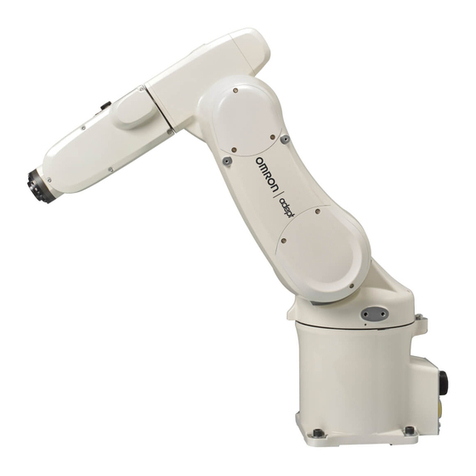
adept technology
adept technology Viper s650 user guide
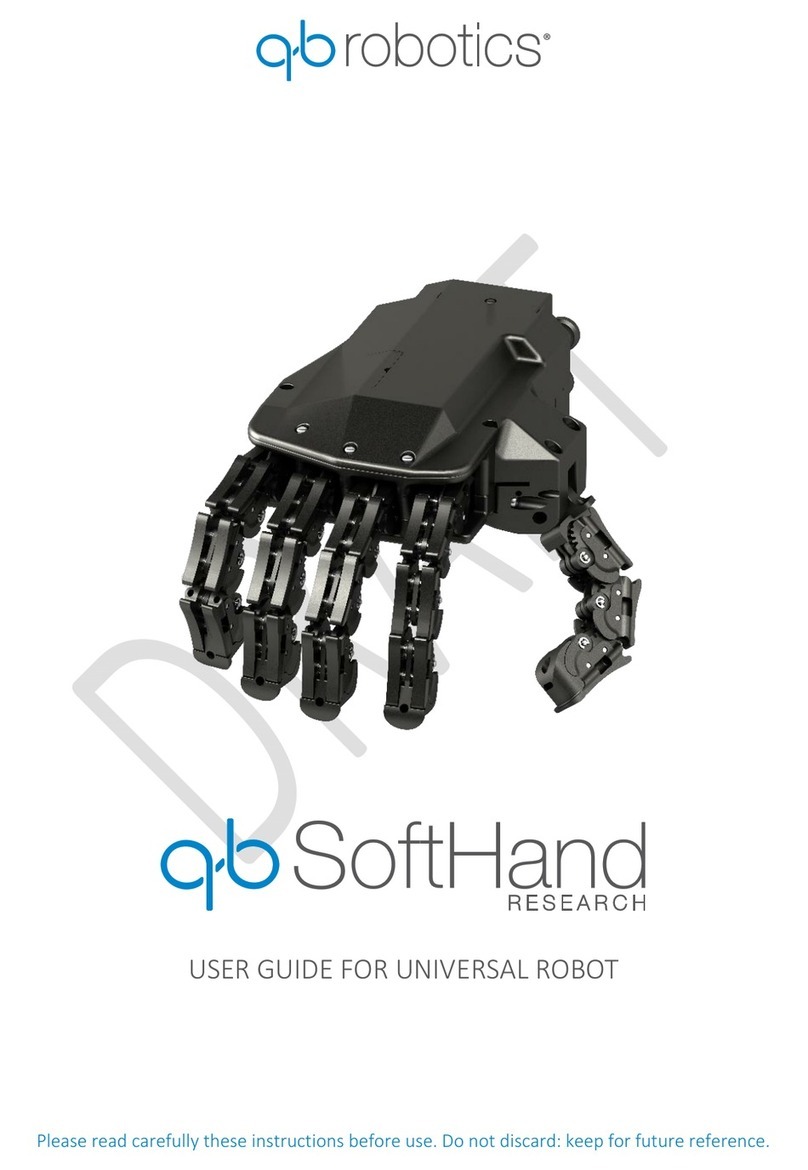
QB Robotics
QB Robotics qb SoftHand RESEARCH user guide

MantaroBot
MantaroBot TeleMe 2 Assembly instructions & quick start guide
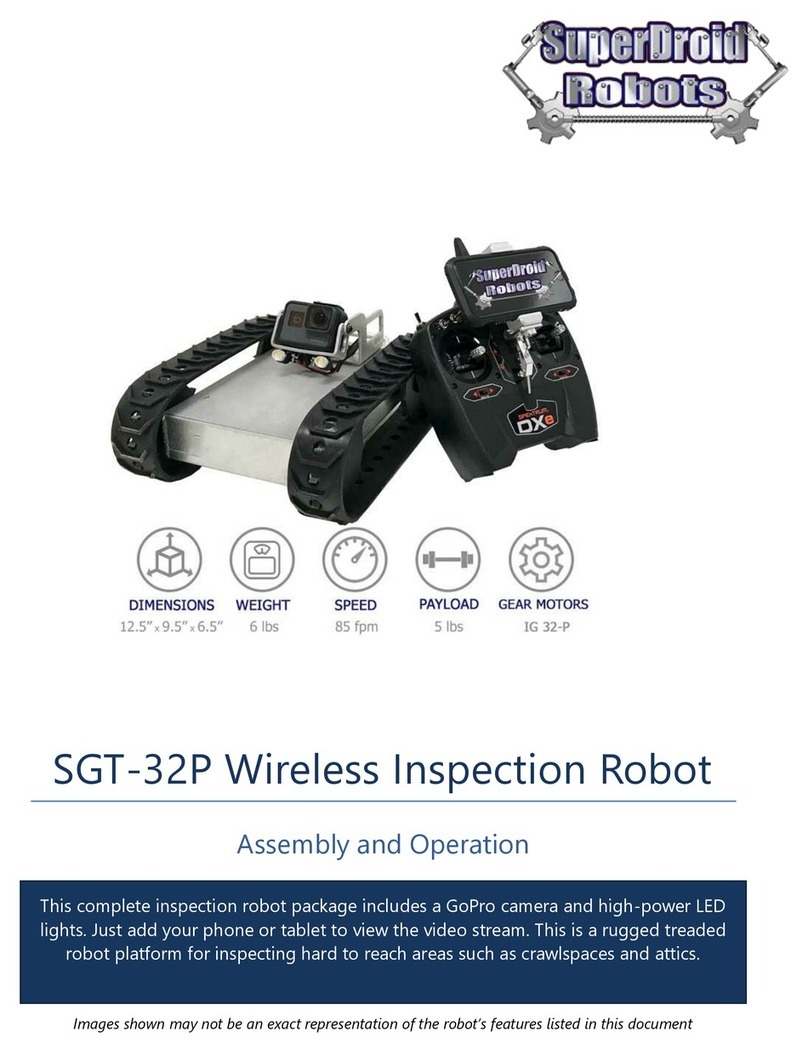
SuperDroid Robots
SuperDroid Robots SGT-32P Assembly and operation
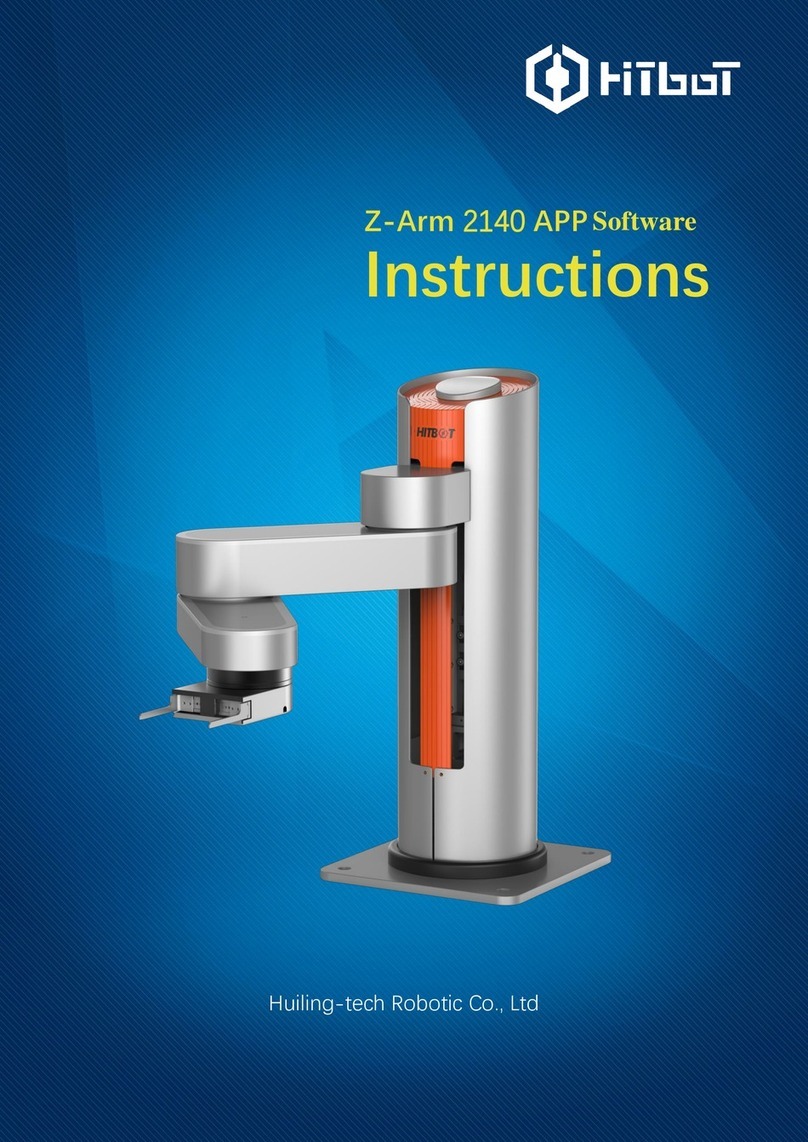
Hitbot
Hitbot Z-Arm 2140 instructions
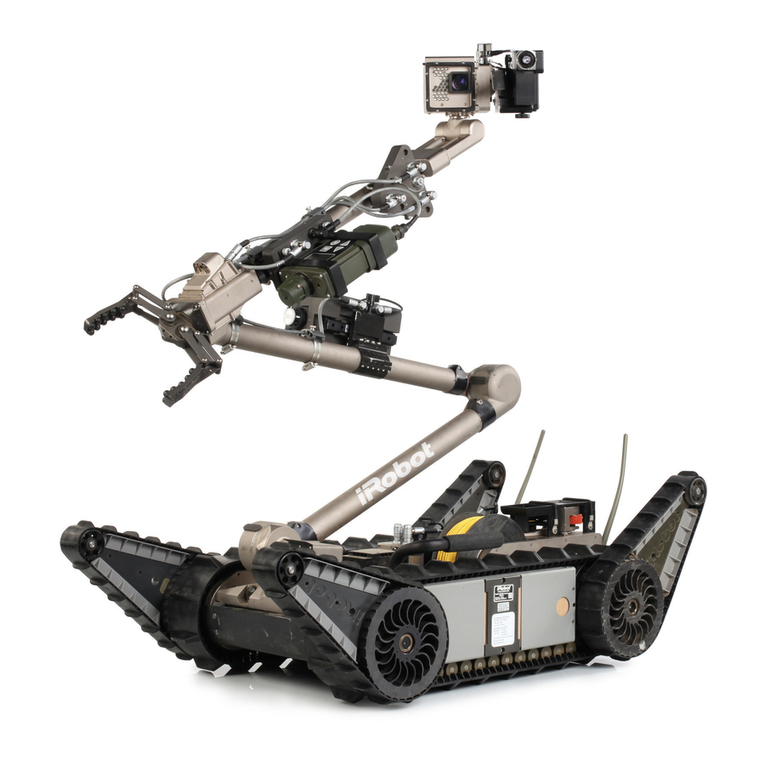
iRobot
iRobot PackBot Accessories
